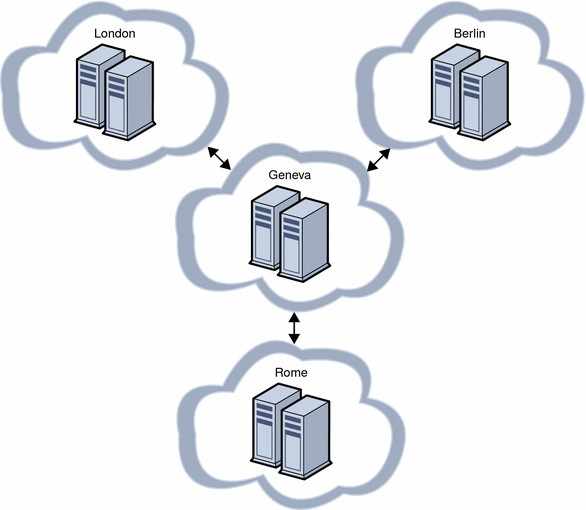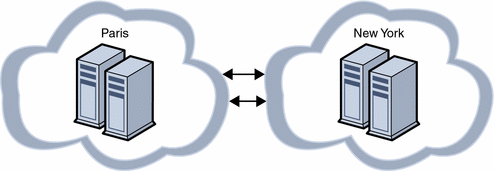Geographically Distributed Cluster Topology
A partnership establishes communication and a heartbeat between clusters. One cluster can participate in several partnerships. A protection group establishes data replication between partner clusters. You can configure several protection groups for a partnership, with each protection group replicating different data between the partner clusters.
The following figure illustrates a geographically distributed topology that demonstrates intercluster relationships.
Figure 3–4 Geographically Distributed Topology

The Sun Cluster Geographic Edition software enables you to configure multiple partnerships for a cluster with heartbeats between partner clusters. For example, the Geneva-London-Rome-Berlin topology contains a central cluster in Geneva that forms three separate partnerships with clusters in London, Rome, and Berlin. The partnerships require two-way Internet connections between the following cluster pairs: London and Geneva, Rome and Geneva, and Berlin and Geneva. These partnerships enable the cluster in Geneva to detect failures of the clusters in London, Berlin, and Rome by exchanging heartbeats.
Each partnership has a protection group so that the primary clusters in London, Rome, and Berlin can replicate data to the cluster in Geneva as a secondary cluster.
The following figure illustrates a geographically distributed topology that demonstrates intercluster relationships.

The Paris-New York topology has two clusters that form a partnership with two protection groups. Each cluster is the primary cluster for one protection group, and the secondary cluster for the other protection group. The partnership requires a two-way Internet connection between the two clusters for intercluster management and heartbeats. The two clusters must have a data replication link to support data replication for two protection groups.
In the Geneva-London-Rome-Berlin topology, the cluster in Geneva could become the primary cluster for any of the three protection groups. However, the cluster in Geneva must have adequate provisioning to run all the services that are offered by the application resource groups.
For example, if the cluster in Rome is shut down for maintenance, the cluster in Geneva could be the new primary cluster by using a controlled switchover for the Rome-Geneva protection group. As the new primary cluster for the Rome-Geneva protection group, the cluster in Geneva would host the services that are provided by the application resource groups of the Rome-Geneva protection group. The cluster in Geneva would simultaneously serve as the secondary cluster for the clusters in London and Berlin.
Similarly, in the Paris-New York topology, either cluster could take over as the primary cluster to both protection groups if the partner cluster were unexpectedly lost.
- © 2010, Oracle Corporation and/or its affiliates
